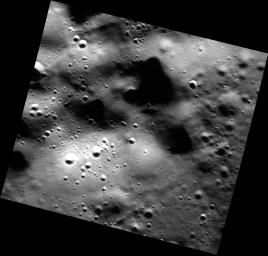
|
The Hills Have Eyes
- Click the image above for a larger view
- Full-Res JPEG (664 x 635) (49.0 kB)
- Full-Res TIFF (664 x 635) (422.3 kB)
Caption:
Today's image features several rolling hills within the northern plains of Mercury. Though covered by smooth plains material, these hills are associated with the rim of an unnamed buried crater. At this high resolution, many small craters can be seen dotting the landscape, some as small as ~20-30 m (65-100 ft) in diameter.
This image was acquired as part of the MDIS low-altitude imaging campaign. During MESSENGER's second extended mission, the spacecraft makes a progressively closer approach to Mercury's surface than at any previous point in the mission, enabling the acquisition of high-spatial-resolution data. For spacecraft altitudes below 350 kilometers, NAC images are acquired with pixel scales ranging from 20 meters to as little as 2 meters.
Date acquired:
April 04, 2014
Image Mission Elapsed Time (MET):
38930993
Image ID:
6061617
Instrument:
Narrow Angle Camera (NAC) of the Mercury Dual Imaging System (MDIS)
Center Latitude:
81.67°
Center Longitude:
234.2° E
Resolution:
16 meters/pixel
Scale:
This image is about 9 km (5.6 mi) across.
Incidence Angle:
81.9°
Emission Angle:
21.9°
Phase Angle:
82.3°
Background Info:
The MESSENGER spacecraft is the first ever to orbit the planet Mercury, and the spacecraft's seven scientific instruments and radio science investigation are unraveling the history and evolution of the Solar System's innermost planet. MESSENGER acquired over 150,000 images and extensive other data sets. MESSENGER is capable of continuing orbital operations until early 2015.
For information regarding the use of images, see the MESSENGER image use policy .
Cataloging Keywords:
| Name | Value | Additional Values |
|---|---|---|
| Target | Mercury | |
| System | ||
| Target Type | Planet | |
| Mission | MESSENGER | |
| Instrument Host | MESSENGER | |
| Host Type | Orbiter | |
| Instrument | Mercury Dual Imaging System (MDIS) | |
| Detector | Narrow Angle Camera (NAC) | |
| Extra Keywords | Crater, Grayscale, Radio | |
| Acquisition Date | ||
| Release Date | 2014-06-03 | |
| Date in Caption | 2014-04-04 | |
| Image Credit | NASA/Johns Hopkins University Applied Physics Laboratory/Carnegie Institution of Washington | |
| Source | photojournal.jpl.nasa.gov/catalog/PIA18446 | |
| Identifier | PIA18446 | |
